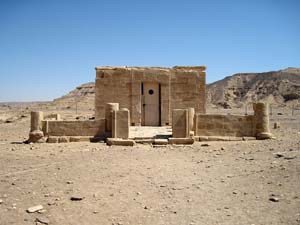El Kab
 El Kab is an Upper Egyptian site on the east bank of the Nile at the mouth of Wadi Hillal, about 80 km south of Luxor, consisting of prehistoric and Pharaonic settlements, rock-cut tombs of the early 18th Dynasty (1550–1295 BC), remains of temples dating from the Early Dynastic period (3100–2686 BC) to the Ptolemaic period (332–30 BC), as well as part of the walls of a Coptic monastery. El Kab is also referred to as the ancient town of Nekheb, and this name Nekheb in turn refers to Nekhbet, the goddess depicted as a white vulture. This site was first scientifically excavated by James Quibell at the end of the nineteenth century, but other archaeologists have spent time at this site include Frederick William Green, Archibald Henry Sayce, Joseph John Tylor, and Somers Clarke. However, Belgian archaeologists took over the project in 1937, and it has remained in their hands since then. Much of the research done at this site took place within the town enclosure of El-Kab. However, since the 1980s the work has shifted more to the north and north east of the town.
El Kab is an Upper Egyptian site on the east bank of the Nile at the mouth of Wadi Hillal, about 80 km south of Luxor, consisting of prehistoric and Pharaonic settlements, rock-cut tombs of the early 18th Dynasty (1550–1295 BC), remains of temples dating from the Early Dynastic period (3100–2686 BC) to the Ptolemaic period (332–30 BC), as well as part of the walls of a Coptic monastery. El Kab is also referred to as the ancient town of Nekheb, and this name Nekheb in turn refers to Nekhbet, the goddess depicted as a white vulture. This site was first scientifically excavated by James Quibell at the end of the nineteenth century, but other archaeologists have spent time at this site include Frederick William Green, Archibald Henry Sayce, Joseph John Tylor, and Somers Clarke. However, Belgian archaeologists took over the project in 1937, and it has remained in their hands since then. Much of the research done at this site took place within the town enclosure of El-Kab. However, since the 1980s the work has shifted more to the north and north east of the town.
Description of Site
El-Kab is in Upper Egypt, located on the east side of the Nile River, almost to the opposite of Hierakonpolis (on the other side of the river) and about fifty miles above Thebes. With the way the river meandered and eroded the rocks and sand, the Nile River is almost level with the town, but according to Clarke Somers in his journal article "El-Kab and the Great Wall," "in its early youth the town must have stood well above the flood waters." The site could be described as a bay between sandstone cliffs to the north and south, and this same sandstone was used to build the temples found in this site.